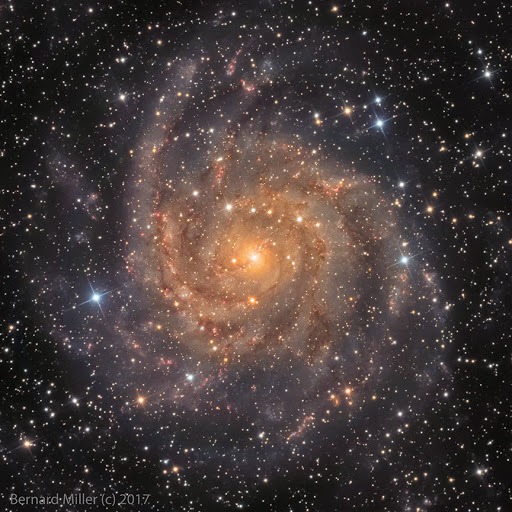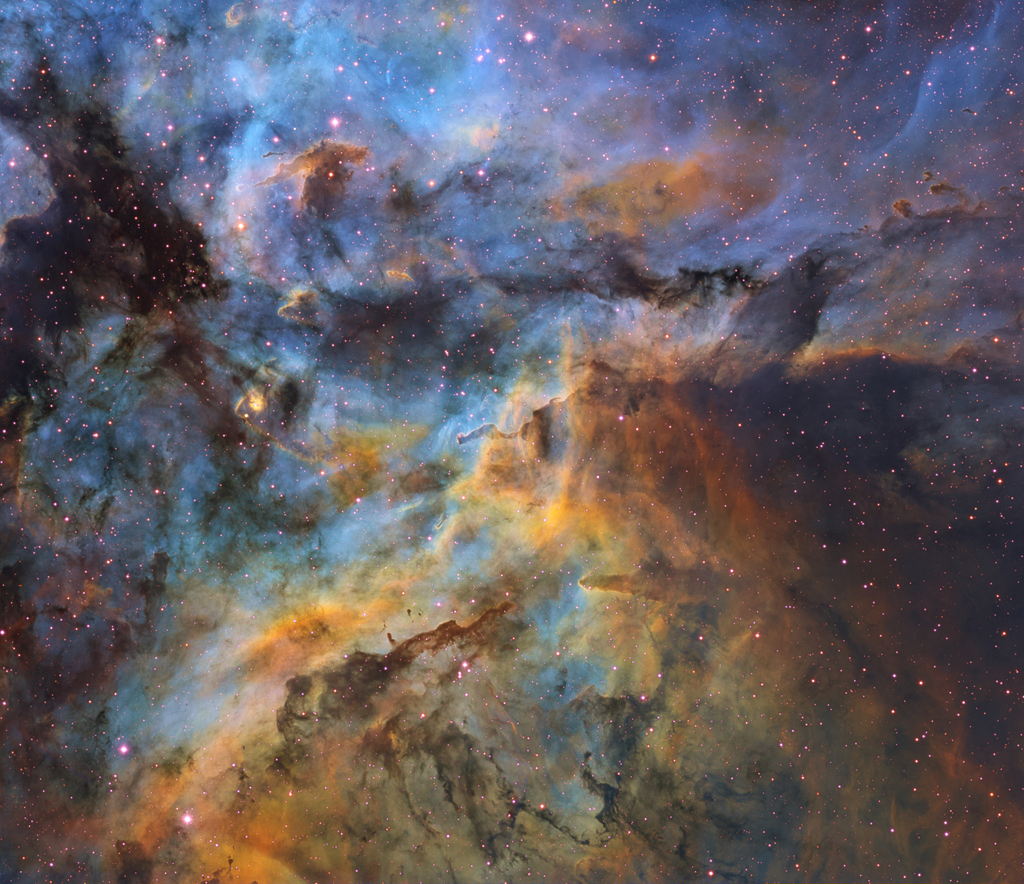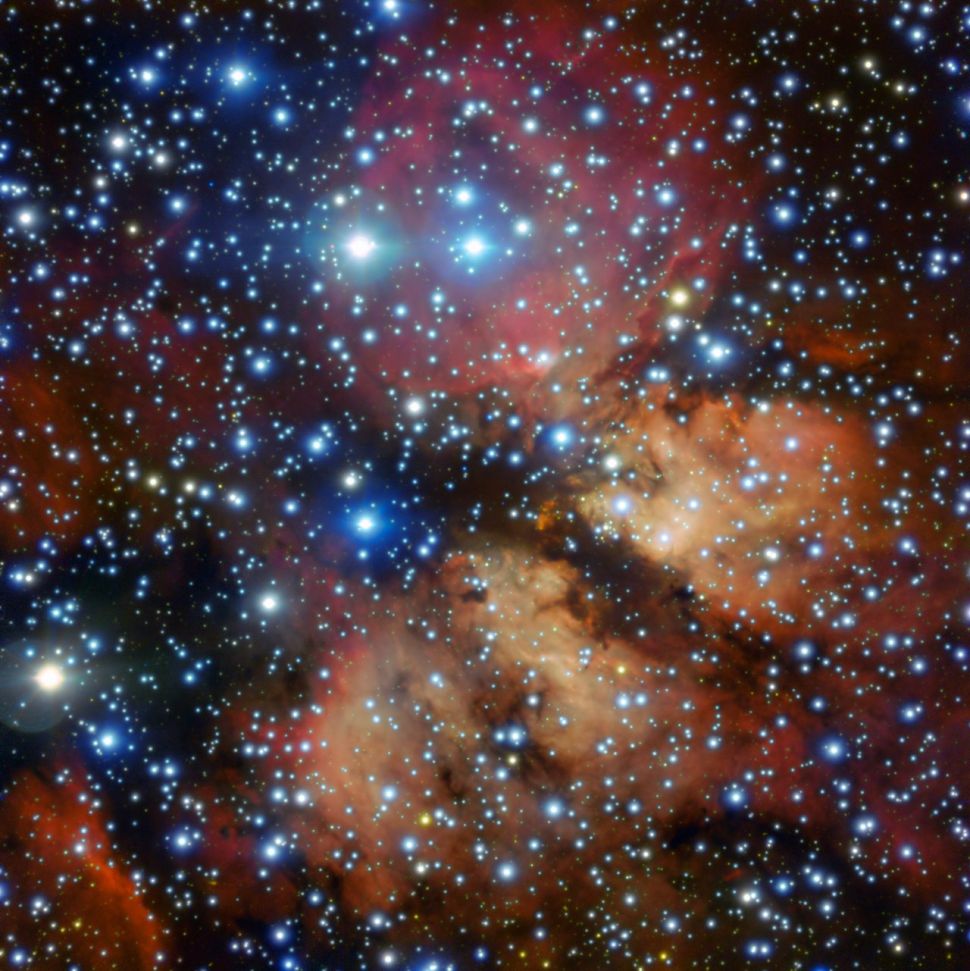Blog
IC 342 (also known as Caldwell 5) is an intermediate spiral galaxy in the constellation Camelopardalis, located relatively close to the Milky Way. Despite its size and actual brightness, its location in dusty areas near the galactic equator makes it difficult to observe, leading to the nickname “The Hidden Galaxy”, though it can readily be detected even with binoculars. If the galaxy were not obscured, it would be visible by naked eye. The dust makes it difficult to determine its precise distance; modern estimates range from about 7 Mly to about 11 Mly. The galaxy was discovered by William Frederick Denning in 1892. It is one of the brightest in the IC 342/Maffei Group, one of the closest galaxy groups to the Local Group. Edwin Hubble first thought it to be in the Local Group, but it was later determined not to be a member.
In 1935, Harlow Shapley found that it was wider than the full moon, and by angular size the third-largest spiral galaxy then known, smaller only than the Andromeda Galaxy (M31) and the Triangulum Galaxy (M33). (Modern estimates are more conservative, giving the apparent size as one-half to two-thirds the diameter of the full moon).
It has an H II nucleus. The galaxy has a diameter of 75 000 light-years.

Ramon “Tiki” Fulwood (May 23, 1944 – October 29, 1979) was an American musician. He was the drummer for the funk bands Parliament and Funkadelic, as well as a member of the Rock and Roll Hall of Fame, inducted in 1997 with fifteen other members of Parliament-Funkadelic. Tiki was known for his loud, hard hitting and raw drumming, and his versatility in tempo.
Fulwood was born in Philadelphia, Pennsylvania in 1944. He worked a paper route as a youth and when becoming seriously interested in the drums, he found inspiration in the legendary Motown drummer, Richard Pistol Allen. In the late 1960s, Fulwood was the house drummer for the Uptown Theater in Philadelphia when he met guitarist Eddie Hazel. Hazel and bassist Billy Bass Nelsonwere on tour as musical support for the doo wop vocal group The Parliaments. Hazel and Nelson convinced group leader George Clinton to add Fulwood to the group, where he replaced drummer Harvey McGee. Fulwood, Hazel, and Nelson formed the core of The Parliaments musical backing group, which later became known as Funkadelic. Fulwood first quit Funkadelic in 1971 following a pay dispute with Clinton, but played with Parliament-Funkadelic sporadically thereafter.
He alongside his Funkadelic cohorts contributed heavily to Ruth Copeland’s first two albums, Self Portrait and I Am What I Am. It is believed Hazel asked him to return full time in 1973. Besides Tyrone Lampkin, a fellow P-Funk drummer, Fulwood returned as the main drummer from 1974-1975. Jerome Brailey replaced Fulwood after he had gotten into a serious altercation with Clinton over compensation. Despite no longer being the premier drummer, Tiki however was featured on Parliament-Funkadelic related side projects, such as Brides of Funkenstien, Bootsy’s Rubberbandand Eddie Hazel. Tiki also drummed on tracks by Jeannie Reynolds, Brother Robert and CJ and Co.
Fulwood also played drums in the Tyrone Davis band and the Chairmen of the Board between stints with P-Funk, and later was briefly employed by Miles Davis. He moved to Washington, D.C to form his own band with the help of his neighbor Wilbur Harris, whom he was mentoring. Around 1977 or so, they recorded much material that is still unreleased to this day. Fulwood died of stomach cancer in late 1979 at age 35 after a year’s diagnosis. His parents had also succumbed to this family ailment in the early 1970’s. In 2016, Rolling Stone ranked Fulwood at no. 39 in its 100 greatest drummers of all time, and in 2013 Spin named ranked him at no. 76 in its 100 greatest drummers of alternative music. When the P-Funk collective was inducted into the Rock and Roll Hall of Fame in 1997, Tiki’s daughter accepted his award in memory of him.
more...Famoudou Don Moye, (born May 23, 1946) is an American jazz percussionist and drummer. He is most known for his involvement with the Art Ensemble of Chicago and is noted for his mastery of African and Caribbean percussion instruments and rhythmic techniques.
Moye was born in Rochester, New York and performed in various drum and bugle corps during his youth, as well as church choir. Moye has commented that he really “didn’t have an affinity for the bugle … and just kind of gravitated towards drums.”[2] He also took violin lessons during this time. Moye was exposed to jazz at an early age since his mother worked for a local social club that had a jazz club next door that hosted musicians such as Kenny Burrell and Jimmy McGriff. His family was also musically inclined; his uncles played saxophones and his father played drums. Also, his mother used to take him to various performances as a child, such as “opera under the stars” and to see Mahalia Jackson.
Moye went on to study percussion at Wayne State University in Detroit, Michigan. Moye lived in a building with trumpeter Charles Moore, who became his mentor. Moye also played in the groups African Cultural Ensemble, which included musicians from African countries such as Ghana, and Detroit Free Jazz, which was Moore’s band. It was at this time that he first encountered the Association for the Advancement of Creative Musicians (AACM) due to the revolving door of musicians in and out of Moore’s residence. In early 1968, Moore’s band traveled to Europe and Moye decided to live there for the next couple of years, touring and visiting the continent as well as Northern Africa.
more...Leslie Spann Jr. (May 23, 1932 – January 24, 1989) was an American jazz guitarist and flautist. As a sideman he recorded with Nat Adderley, Benny Bailey, Bill Coleman, Eddie “Lockjaw” Davis, Curtis Fuller, Red Garland, Benny Goodman, Sam Jones, Abbey Lincoln, Charles Mingus, Duke Pearson, Jerome Richardson, Charlie Shavers, Sonny Stitt, Billy Taylor, Randy Weston, and Ben Webster. As a leader he recorded only once, the album Gemini in 1961.
Les Spann was born in Pine Bluff, Arkansas, United States. From 1950–1957, he studied music at Tennessee State University. At the end of that time he worked with Phineas Newborn Jr. and in 1958 with Ronnell Bright. The following year, he joined a quintet in New York City led by Dizzy Gillespie, performing solos on flute and guitar and appearing on two of Gillespie’s albums for Verve Records. After a year with Gillespie, he went to Europe as a member of Quincy Jones‘s big band. Two more albums followed, this time with Spann joining a sextet that included Duke Ellington, Johnny Hodges, and Harry “Sweets” Edison. He recorded with Hodges again in 1967, then disappeared from the music industry. He died in New York City in 1989.
more...Alicia de Larrocha y de la Calle (23 May 1923 – 25 September 2009) was a Spanish pianist and composer. She was considered one of the great piano legends of the 20th century. Reuters called her “the greatest Spanish pianist in history”, Time “one of the world’s most outstanding pianists”, and The Guardian “the leading Spanish pianist of her time”.
She won multiple Grammy Awards and a Prince of Asturias Award for the Arts. She is credited with bringing greater popularity to the compositions of Isaac Albéniz and Enrique Granados. In 1995, she became the first Spanish artist to win the UNESCO Prize.
more...With natal dust clouds in silhouette against glowing atomic gas, this colorful and chaotic vista lies within one of the largest star forming regions in the Milky Way galaxy, the Great Carina Nebula. The telescopic close-up frames a field of view about 80 light-years across, a little south and east of Eta Carinae, the nebula’s most energetic and enigmatic star. Captured under suburban skies improved during national restrictions, a composite of narrowband image data was used to create the final image. In it, characteristic emission from the nebula’s ionized sulfur, hydrogen, and oxygen atoms is mapped to red, green, and blue hues, a color palette also popular in Hubble Space Telescope images. The celestial landscape of bright ridges of emission bordered by cool, obscuring dust lies about 7,500 light-years away toward the southern constellation Carina.

Bernard John Taupin (born 22 May 1950) is an English lyricist, poet, singer and artist. He is best known for his long-term collaboration with Elton John, having written the lyrics for most of John’s songs.
In 1967, Taupin answered an advertisement placed in the UK music paper New Musical Express by Liberty Records, a company that was seeking new songwriters. John responded to the same advertisement and they were brought together, collaborating on many projects since. Taupin and John were inducted into the Songwriters Hall of Fame in 1992.
more...Richard Alan “Dick” Berk (May 22, 1939 – February 8, 2014) was an American jazz drummer and bandleader.[1]
Berk was born in San Francisco, California. He studied at the Berklee College of Music and played in the Boston area early in the 1960s. In 1962 he moved to New York City and played there with Ted Curson and Bill Barron in a quintet from 1962 to 1964. Following this he played with Charles Mingus, Mose Allison, Freddie Hubbard, and Walter Bishop, Jr., among others. He moved to Los Angeles late in the 1960s, where he played with Milt Jackson, George Duke, Cal Tjader, Jean-Luc Ponty, and Blue Mitchell. He founded the Jazz Adoption Agency in the early 1980s, playing into the 2000s; among this group’s alumni are Andy Martin, Mike Fahn, Nick Brignola, Jon Nagorney, Keith Saunders, Tad Weed, and John Patitucci.
He died in 2014, aged 74.
more...Giuseppi Logan (May 22, 1935 – April 17, 2020) was a jazz musician, originally from Philadelphia, Pennsylvania, who taught himself to play piano and drums before switching to reeds at the age of 12. At the age of 15 he began playing with Earl Bostic and later studied at the New England Conservatory. In 1964 he relocated to New York and became active in the free jazz scene.
Logan played alto and tenor saxophone, bass clarinet, flute, piano and oboe. He collaborated with Archie Shepp, Pharoah Sanders and Bill Dixonbefore forming his own quartet made up of pianist Don Pullen, bassist Eddie Gómez and percussionist Milford Graves. After Pullen’s departure, pianist Dave Burrell joined the group. Logan was a member of Byard Lancaster‘s band and toured with and appeared on records by Patty Waters. He recorded two albums for the ESP-Disk record label and later appeared on an album by Roswell Rudd on the Impulse! label. A 1965 press release from ESP-Disk indicates that a third album was planned, but never released, possibly due to Logan’s increasingly erratic behavior. This title was supposed to have been ESP-1018, The Giuseppi Logan Chamber Ensemble in Concert, but this catalogue number was eventually assigned to an album by The Fugs.
more...Le Sony’r Ra (born Herman Poole Blount, May 22, 1914 – May 30, 1993), better known as Sun Ra, was an American jazz composer, bandleader, piano and synthesizer player, and poet known for his experimental music, “cosmic” philosophy, prolific output, and theatrical performances. For much of his career, Ra led “The Arkestra”, an ensemble with an ever-changing name and flexible line-up.
Born and raised in Alabama, Blount became involved in the Chicago jazz scene during the late 1940s. He soon abandoned his birth name, taking the name Le Sony’r Ra, shortened to Sun Ra (after Ra, the Egyptian God of the Sun). Claiming to be an alien from Saturn on a mission to preach peace, he developed a mythical persona and an idiosyncratic credo that made him a pioneer of Afrofuturism. Throughout his life he publicly denied ties to his prior identity.
His widely eclectic and avant-garde music echoed the entire history of jazz, from ragtime and early New Orleans hot jazz, to swing music, bebop, free jazz and fusion. His compositions ranged from keyboard solos to works for big bands of over 30 musicians, along with electronic excursions, songs, chants, percussion pieces, and anthems. From the mid-1950s until his death, Ra led the musical collective The Arkestra (which featured artists such as Marshall Allen, John Gilmore and June Tyson throughout its various iterations). Its performances often included dancers and musicians dressed in elaborate, futuristic costumes inspired by ancient Egyptian attire and the Space Age. (Following Ra’s illness-forced retirement in 1992, the band remained active as The Sun Ra Arkestra, and, as of 2018, continues performing under the leadership of veteran Ra sideman Marshall Allen.)
Though his mainstream success was limited, Sun Ra was a prolific recording artist and frequent live performer, and remained influential throughout his life for his music and persona. He is now widely considered an innovator; among his distinctions are his pioneering work in free improvisation and modal jazz and his early use of electronic keyboards and synthesizers. Over the course of his career, he recorded dozens of singles and over one hundred full-length albums, comprising well over 1,000 songs, making him one of the most prolific recording artists of the 20th century.
He was born Herman Blount on May 22, 1914, in Birmingham, Alabama, as discovered by his biographer, John F. Szwed, and published in his 1998 book. He was named after the popular vaudeville stage magician Black Herman, who had deeply impressed his mother. He was nicknamed “Sonny” from his childhood, had an older sister and half-brother, and was doted upon by his mother and grandmother.
For decades, very little was known about Sun Ra’s early life, and he contributed to its mystique. As a self-invented person, he routinely gave evasive, contradictory or seemingly nonsensical answers to personal questions, and denied his birth name. He speculated, only half in jest, that he was distantly related to Elijah Poole, later known as Elijah Muhammad, leader of the Nation of Islam. His birthday for years remained unknown, as his claims ranged from 1910 to 1918. Only a few years before his death, the date of Sun Ra’s birth was still a mystery. Jim Macnie’s notes for Blue Delight (1989) said that Sun Ra was believed to be about 75 years old. But Szwed was able to uncover a wealth of information about his early life and confirmed a birth date of May 22, 1914.
more...Rumba flamenca, also known as flamenco rumba or simply rumba (Spanish pronunciation: [ˈrumba]), is a palo (style) of flamenco music developed in Andalusia, Spain. It is known as one of the cantes de ida y vuelta (roundtrip songs), music which diverged in the new world, then returned to Spain in a new form. The genre originated in the 19th century in Andalusia, southern Spain, where Cuban music first reached the country.
more...Colorful stars sparkle across a sea of cosmic dust and gas in this new view of Gum 26, a star-forming region in the Milky Way galaxy. Located 20,000 light-years from Earth in the constellation of Vela, the sails, Gum 26 is a hydrogen-rich emission nebula, also known as an H II region, where collapsing clumps of dust and gas are actively forming new stars. This new image of the stellar nursery was captured by the European Southern Observatory’s Very Large Telescope in Chile.

Leo Sayer (born Gerard Hugh Sayer, 21 May 1948) is an English-Australian singer-songwriter musician and entertainer whose singing career has spanned four decades. He is now an Australian citizen and resident.
Sayer launched his career in the United Kingdom in the early 1970s, and became a top singles and album act on both sides of the Atlantic in the 1970s. His first seven hit singles in the United Kingdom all reached the Top 10 – a feat first registered by his first manager, Adam Faith. His songs have been sung by other notable artists, including Cliff Richard (“Dreaming“).
more...Larance Norman Marable (May 21, 1929 – July 4, 2012) was a jazz drummer from Los Angeles, California.
Marable was born in Los Angeles on May 21, 1929. His family was musical, but he was largely self-taught.
In the 1950s, Marable played with musicians who were visiting Los Angeles; these included Dexter Gordon, Charlie Parker, and Zoot Sims. Marable recorded as a leader in 1956.He also recorded with George Shearing, Chet Baker, Milt Jackson, and other well-known musicians.
Drug problems led to Marable stopping playing in the 1960s. His career resumed in the mid-1970s, after he had ended his drug addiction. He toured with Supersax and Bobby Hutcherson in the 1970s, and was a member of Charlie Haden‘s Quartet West in the 1980s and 1990s. Marable had a stroke in the 2000s and lived in a health care facility.He died in Manhattan on July 4, 2012.
https://www.youtube.com/watch?v=QFDYe4oYGyI
more...More Posts
- Betraying Heros
- Science Reality
- Curley Russell
- Cosmo NGC 2359
- Tom Constanten
- Clarence Frogman Henry
- Buster Bennett
- Buster Harding
- Lenny Tristano
- World Fusion Tigran Hamasyan
- Daily Roots Prince Jammy
- Cosmo LDN 1235
- Big Daddy Kinsey
- Wilson Pickett
- Jose Mangual Sr
- Andy Narell
- Bill Frisell
- World Music Mohammed Reza Shadjarian & Ensemble Aref
- Daily Roots Ras Pidow
- Feed the Children